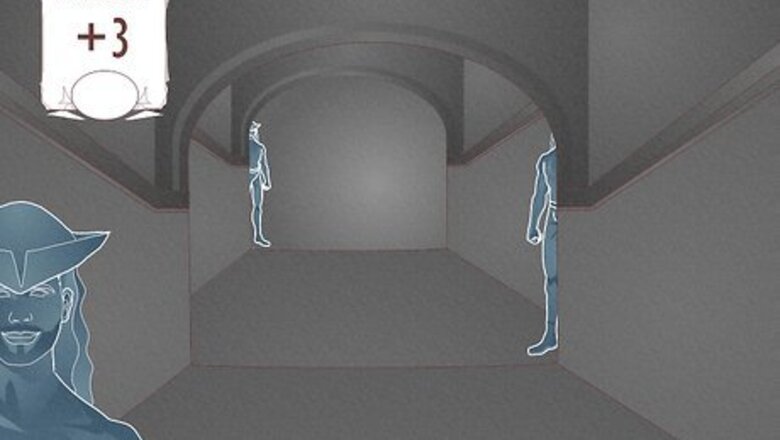
views
- Stealth is a Dexterity-based skill in D&D 5e that measures a character’s ability to hide from enemies and sneak around without being noticed.
- If your character is proficient in stealth, calculate stealth by adding their DEX bonus + proficiency bonus. Double the proficiency bonus if they have expertise.
- If your character isn’t proficient, their stealth and Dexterity modifiers are the same. Add their DEX modifier to a d20 roll when making stealth checks.
What is stealth in D&D 5e?
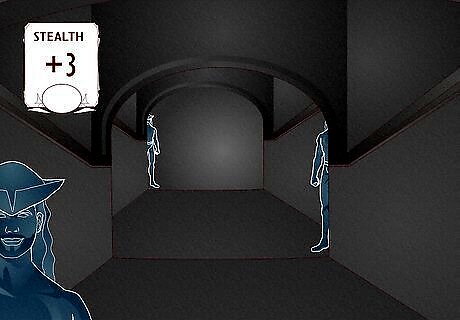
Stealth is a skill that allows characters to hide or sneak around. In D&D 5e, player characters (PCs) have a whole list of skills at their disposal, from persuasion to athletics—and one of those skills is stealth. Stealth determines a PC’s ability to be sneaky and avoid being seen or heard when they want to. All stealth checks are based on a PC’s Dexterity (DEX) score. Dexterity is one of the 6 ability scores that all creatures (and PCs) in D&D have; the others are Strength, Constitution, Intelligence, Wisdom, and Charisma. Dexterity encompasses a number of physical abilities in D&D, including coordination, agility, reflexes, fine motor skills, balance, and speed of movement. In addition to stealth, Dexterity also influences other skills like acrobatics and sleight of hand.
Calculating Stealth Modifiers
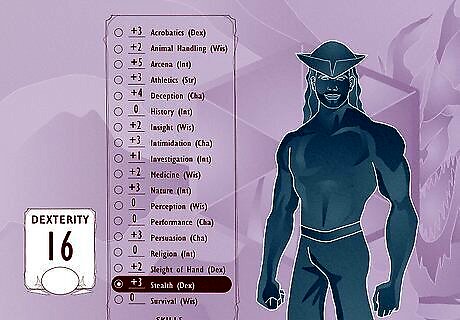
A PC’s base stealth modifier equals their DEX bonus. Every ability score has a modifier—and if you’re not sure what your PC’s current modifier should be, look it up in the D&D rulebook! If you’re playing a PC that doesn’t have proficiency in stealth, there’s no math required; since Dexterity rules stealth, their stealth modifier is the same as their DEX modifier. Modifiers are values based on a PC’s ability scores. They determine your PC’s success in skill checks and can be positive or negative (depending on the ability score value). For example, if you rolled ability scores for your PC and gave them a 16 to Dexterity, their DEX modifier would be +3 according to D&D rules. If your PC didn’t have proficiency in stealth, their stealth modifier would also be +3.
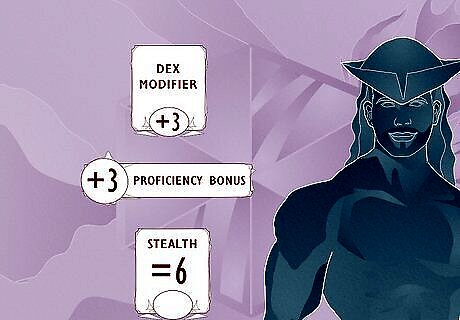
Characters with proficiency in stealth can add their proficiency bonus. In D&D, characters get proficiencies in certain skills, meaning they have some training in those areas beyond their natural ability and, therefore, get a bonus on d20 rolls when using those skills. If your character is proficient in stealth, the formula to calculate stealth is: DEX modifier + proficiency modifier = stealth modifier. For example, if your character had proficiency in stealth, a +3 DEX modifier, and a +3 proficiency bonus, their stealth modifier would be 3 + 3 or 6 in total. Most classes allow players to choose their PC’s proficiencies from a small pool of relevant skills. If you play a rogue, for example, stealth is one of the skills you might be able to give your character proficiency in.

Characters with expertise in stealth can double their proficiency bonus. If your character has expertise in a skill, that essentially means they’ve mastered it! To make a stealth check when your PC has expertise in the skill, simply add their DEX modifier + proficiency bonus + proficiency bonus (or rather, double their proficiency bonus and then add their DEX modifier). Expertise is a step above proficiency. If your character has expertise in stealth (or any other skill), it’ll be marked next to that skill on their character sheet. Proficiency bonuses (and expertise bonuses) change steadily as your PCs level up. Every PC has a proficiency bonus of +2 at level 1—but at level 20, the proficiency bonus is +6. So, for example, if your PC had a DEX modifier of +3 and expertise in stealth, their stealth modifier at level 1 would be 3 + 2 + 2, or 7 in total. At level 20, their stealth modifier would be 3 + 6 + 6, or 15 in total.
Making Stealth Checks

Roll a d20 and add the result to your character’s stealth modifier. You may also need to “calculate stealth” when it comes to making stealth checks as you play D&D—but thankfully, the calculation is simple. When your DM (Dungeon Master) asks you to make a stealth check for your PC, simply roll a d20 and add their stealth modifier. That’s why it’s so important to know your PC’s skill modifier’s before you sit down to play! For example, if your PC’s modifier was a +6 and you rolled a 10 on the d20, their total stealth check would be 10 + 6 or 16. A d20 is the 20-sided dice that players roll when the DM asks for a skill check, attack roll, or saving throw—and stealth rolls are a type of skill check.
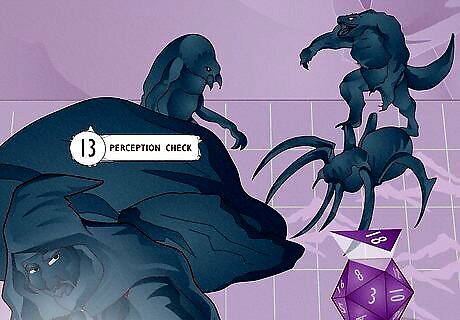
Determine if your character can hide successfully with stealth checks. Throughout the game, your PC will need to make ability and skill checks—whether you’re sneaking down hallways or attempting to recall an obscure piece of history. When you make a stealth check, your DM is responsible for setting the difficulty (DC) of the check and telling you whether your PC succeeded or failed based on their roll. For example, if your PC’s stealth check is a 16 and the DC to hide successfully is 15, your character would pass the check! Sometimes, instead of a DC, your DM may ask you to make a stealth check contested by another creature making a perception check. Perception is another skill that determines a PC’s awareness of their environment. For example, if you’re trying to sneak past an enemy and rolled an 18 for your stealth check versus a 13 for their perception check, your PC would be able to sneak past them successfully.
Using Stealth in D&D 5e

Hide in combat to avoid attacks and reduce the damage you take. Take the “hide” action to prevent enemies from seeing you. So long as enemies don’t have a direct line of sight on you, your DM may let you roll a stealth check during combat. From there, enemies who can’t see you have disadvantage on attack rolls if they try to hit you. For example, if your character ducks behind a pile of rubble and then rolls a successful stealth check, they’re considered hidden—and enemies will have a hard time hitting them. Disadvantage means rolling d20s for a check, attack roll, or saving throw twice and taking the lower roll (making the enemy less likely to succeed).

Conceal yourself or move quietly to stop creatures from noticing you. Stealth also lets your PC sneak around obstacles rather than facing them head-on in combat. Use stealth to hide in the shadows, walk silently, sneak past unsuspecting foes, and scout dark dungeons without enemies seeing or hearing. In short, stealth lets you pull off all kinds of covert moves in D&D! For example, if you wanted to try and slip past a group of tough-looking guards rather than fighting them, use stealth to pull it off.

Ambush and sneak attack enemies to do extra damage in battle. If you plan a successful ambush, you may end up doing critical damage to enemies before they even get a chance to retaliate and attack you in return! Roll a stealth check to conceal yourself and lay in wait for your enemy (or, depending on the situation, sneak up on them). If enemies can’t see you coming, your PC will get advantage on their initial attack rolls. For example, if your PC hides in a tree and waits for the ogre they’re hunting to pass by, they can jump down and deal a strike without the ogre spotting them—and get advantage on the attack. Similar to disadvantage, advantage means rolling d20s for a check, attack roll, or saving throw twice and taking the higher of the two (making you more likely to succeed). This is an especially useful mechanic if you play as a rogue (since rogues get to add sneak attack damage to rolls that enemies don’t see coming). Rogues with the assassin subclass are particularly effective when it comes to ambushes because they deal extra damage if they strike before the battle begins.

Sneak around in plain sight and blend into crowds to go unnoticed. Your DM may also let you use “social stealth,” which essentially means hiding by being as inconspicuous as possible. Use disguises, illusion spells, or simply walk in the middle of a crowd and roll stealth to see if you attract any attention. Hiding in plain sight can be super useful if your PC needs to infiltrate somewhere as part of a quest! For example, if the goal was to infiltrate an exclusive ball full of nobles and royalty, your character could try to dress up as a noble and blend in with the guests using stealth.

Hide more easily when your PC is invisible (or has a feat). Invisibility naturally makes your PC much harder for enemies (or any creature) to spot, which means you’ll get advantage on any stealth checks you make while invisible. Use invisibility to give your character a leg up on their check! Remember—even though your PC is invisible, it doesn’t mean they’re completely undetectable. For example, if an enemy suspects your character is there, they can make an attack roll with disadvantage, even if they can’t see you. Some racial feats make sneaking easier! For example, wood elves’ Mask of the Wild ability lets them hide when lightly obscured by foliage or weather, and lightfoot halflings have the Naturally Stealthy ability, which lets them hide behind bigger creatures. The skulker feat (which is available to any race or class) also improves stealth, allowing PCs with the feat to use the hide action even when lightly obscured. Feats are additional abilities that players can choose as their PCs level up. Generally, “lightly obscured” means your PC is visible but can’t be seen clearly, or is partially covered by something. Your DM can ultimately determine what counts as “lightly obscured.”




















Comments
0 comment